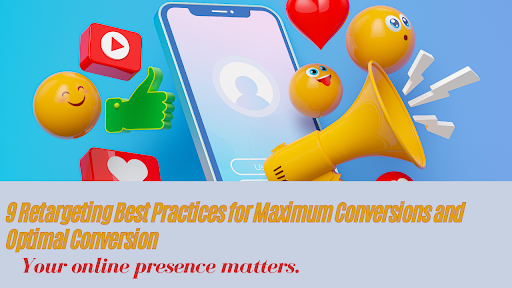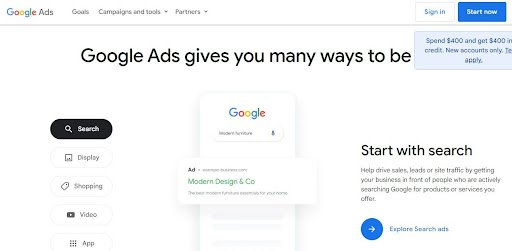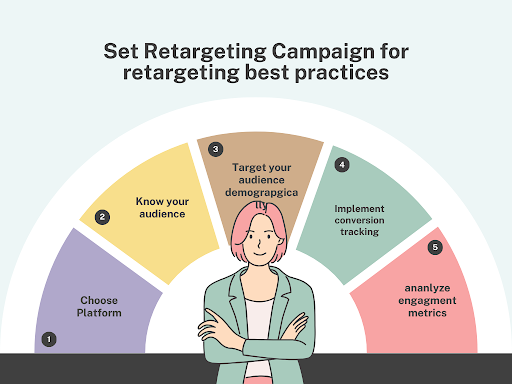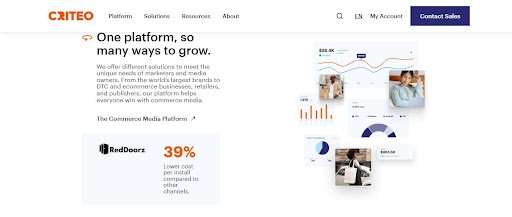Table of Contents
Share This Article :-
1. Retargeting best practice
Are you confused whether to use retargeting or not? Is retargeting beneficial? What are the retargeting best practices? What results does retargeting bring?
Retargeting is used to attract customers and marketers are going to increase its budget by 50% to increase conversions.
In this blog, l will try my best to answer all your queries. We will go through retargeting, its effectiveness, retargeting best practices, and tools that will change the traditional norms of retargeting in 2024.
2. What is “Retargeting” in Retargeting Best Practices? State a few Retargeting examples
77% marketers now use retargeting as an integral part of their instagram and Facebook marketing strategy.
1. Definition of Retargeting
Retargeting is essentially a re-engagement strategy whose main focus is to instigate consumers to re-engage.
Retargeting differs from banner ads and efficiently attracts inactive consumers including those who have cancelled their subscriptions or visited your website and were your customers.

2. Good Retargeting Rate
A good conversion rate for retargeting is 0.9% to 1.23% which is less than prospecting campaigns.
3. Example
Retargeting a consumer who previously purchased by email follow-ups or attracting consumers through Facebook ads.
3. Difference b/w Retargeting and Remarketing?
Remarketing and retargeting are almost the same with minor differences.
Retargeting commonly refers to displaying online ads to individuals who have previously visited your website but left without taking any action. This marketing technique relies on tracking mechanisms like retargeting pixels or cookies, which continue to monitor the user’s activity even after they’ve exited your site.
Remarketing involves engaging with individuals already present within your established channels. This strategy is applicable whether you’re aiming to rekindle interaction with your customers through emails, social media campaigns, or other promotional initiatives. The essence lies in actively involving customers within platforms that you have control over.
1. Main Goals of Remarketing and Retargeting
- Focus on reaching out to visitors who have previously explored your website and are familiar with your brand.
- Target individuals who are highly inclined to make a purchase.
- Begin fostering a deeper connection with customers by enhancing brand visibility and recognition, thereby laying the foundation for meaningful engagement.
4. What are the types of Retargeting?
1. Search retargeting
Search retargeting involves crafting a personalized audience derived from users’ keyword search activities. Advertisers can recognize individuals actively searching for keywords relevant to their offerings and display targeted ads to these users as they browse various websites.

How does Search Retargeting work?
Search retargeting operates automatically. Following a user’s keyword search, specific display ads will appear on their search engine results pages (SERPs), social media platforms(Instagram, Facebook, Youtube, TickTok, etc), and other online pages they frequent.
Search retargeting proves highly effective in elevating brand visibility and attracting increased engagement and traffic to your website. Moreover, consumers exhibit a preference for this advertising method over traditional display ads, making it a compelling choice for marketers.
2. Behavioral Retargeting
Behavioral retargeting or remarketing is an online targeted advertising that mainly revolves around consumers’ behavior based on their internet history. Retargeting best practices involve learning about behavioral targeting and implementing it accordingly.
How does Behavioral Retargeting work?
When someone visits a website, a ‘cookie’ is generated—a small piece of data that helps the site recognize them. This cookie allows the website to gather information about the pages visited by the user, the products they purchase, and even the passwords they utilize.
If someone likes a product but doesn’t buy, cookies track them and text them later.
Personalized campaigns can be tailored by carefully analyzing data, or observing abandoned carts based on their previous purchase history.

For instance
An e-commerce platform specializing in kitchenware targets individuals who have added items to their cart but haven’t completed the purchase.
3. Dynamic Retargeting
To initiate dynamic display ads, you’ll need to configure a personalized Retargeting Tag on your website.
This tag will extract Product Identification numbers from your merchant feed and transmit them to Google.

Subsequently, Google will match these Product IDs with your Google Merchant Center feed, leveraging these attributes to fuel your “dynamic display ads”.
4. Pixel Based Retargeting
The most prevalent approach to reconnect with anonymous website visitors is through pixel-based retargeting.
How does Pixel Based Retargeting work?
Pixel based retargeting operates in the following ways:
- You have to integrate a code snippet (that may be in HTML or JavaScript).
- It comes up with unseen 1×1 images known as pixels onto your web pages.
- It collects relevant user data such as IP addresses.
Pixel-based retargeting offers businesses the advantage of instant and automated targeting, reaching users while they’re actively browsing the web, thereby boosting conversion opportunities. Additionally, it facilitates by targeting users who have previously shown interest in the business by visiting the website.
5. List-based Remarketing
List-based remarketing enables you to reconnect with this group of interested individuals by delivering personalized messages that align with their past engagements.

How does List-based retargeting work?
For list-based retargeting, collect data based on consumer history and target them through personalised ads.
List-based remarketing stands as a powerful asset in the digital marketer’s toolkit. It empowers businesses to interact with an audience already displaying interest, refining marketing endeavors to be more precise and efficient in terms of costs.
5. Is Retargeting effective in 2024?
Benefits of retargeting
1. Higher conversion rates and brand awareness
Retargeting users already interested in your offerings leads to improved conversion rates and brand awareness.
2. Improved ad engagement
Personalized ads captivate user attention, enhancing engagement and overall ad performance.
Cons of Retargeting
1. Ad fatigue and Privacy Concerns
Overexposure to retargeted ads can lead to user fatigue and disengagement alongside increased privacy concerns. Now users care about its privacy more than ever.
2. Ad-blockers
Users employing ad-blockers or cookie preferences limit the effectiveness of retargeting campaigns.
6. 9 Retargeting Best Practices for Optimal Engagement and Conversions in 2024
What are the retargeting best practices? Are you confused about strategies? Which is best or not? Let me clear your queries in this section.

1. Study your Audience keenly for the best conversion and engagement
Recognizing where a user stands in a sales funnel or cycle is paramount. Failing to acknowledge this can result in either overaggressive or insufficient engagement with potential leads or customers.
Selecting the appropriate platform and understanding of audience is crucial. Considering users’ interactions with ads is crucial for enhancing campaign effectiveness and plays a crucial role in creating retargeting best practices.
When you know your audience, you are capable of choosing things with their preference which will increase conversions.
2. Customize your ad through Dynamic Display Ads
Creating ads through dynamic display will be the best retargeting practice in 2024 as it allows you to create that is user-centric.
By personalising content, there is a higher chance of grabbing the viewer’s attention and prompting them to take action such as making a purchase or signing up for email and newsletters, etc.
Dynamic Display Ads can adjust to real-time changes, ensuring the content stays relevant and captivating for the audience.
3. Targeting Customers with Prior Purchases
As email lists evolve, it’s typical for responsiveness to decline gradually with new subscribers joining and older ones disengaging. Continuously running drip campaigns might not effectively combat this churn. Hence, retargeting offers a chance to re-engage with those who have become unresponsive.
Retargeting best practice is to never forget your old customers. Old and regular consumers are the backbone of any brand. Focus on them and retarget them. If customers haven’t made purchases recently, considering them for retargeting efforts can reignite their interest and involvement.
4. Incorporate Retargeting with Other Marketing Tactics
Don’t rely on simple retargeting strategies. Retargeting best practices include using other marketing tactics with retargeting. Use the following tactics to attract consumers.
- Videos play a pivotal role in retargeting marketing, offering the ability to demonstrate products in action or provide informative tutorials.
- Utilize Facebook retargeting ads to reach individuals based on their prior interactions with your website.
- By amalgamating various forms of retargeting content and harnessing the potential of social media and pixel-based retargeting, you can craft campaigns that not only reach the appropriate audience but also foster deeper engagement.
- Employ retargeting initiatives to continually express gratitude and maintain brand visibility, ensuring your brand remains top-of-mind for potential customers.
5. Establish a Cohesive Brand Message Across All Channels
Integrating retargeting into your overall marketing plan is essential for maintaining consistency across all channels. This ensures that your messaging and branding remain cohesive, maximizing the impact of your marketing efforts.
Ensure that your retargeting campaign goals are in line with your broader marketing objectives, whether it’s increasing sales, enhancing brand awareness, or generating leads.
Optimize the duration and frequency of your retargeting ads to maintain user engagement without overwhelming them. Analyzing data will aid in optimizing the campaign and aligning it more effectively with your overall strategy.
6. Apply optimization techniques for retargeting best practices
Utilizing your pixels to create burn lists can optimize your ad spend efficiently. Ensure that your tracking pixels are placed on every page of your website. Tracking user behavior from arrival to checkout offers valuable insights into visitors’ interests and the products that capture their attention.
By creating lists of users who have reached the order confirmation page, you can exclude them from retargeting efforts, ensuring you’re not targeting users who have recently made a purchase. Knowing visitor’s interests will lead you to create one of the best retargeting practices.
7. Customize Ads and Messages for Personalized Engagement
Retargeting empowers businesses to craft ads that are uniquely suited to the preferences and requirements of their intended audience. Through personalized and customized advertisements, that match the interests of their audience, businesses can deliver a more captivating and pertinent advertising journey.
This personalized approach increases the likelihood of individuals engaging with ads that resonate directly with their interests.
8. Set your goals and redefine your KPIs
As a business owner, you have to set clear goals before launching a campaign ad. Your goals may include increasing ROI, brand awareness, and conversion rate.
KPIs formerly known as Key Performance Indicators. It gives a clear idea about the success targeting campaign. Before launching a targeting, you should redefine your KPIs goals which is a crucial best retargeting practice for maximum outcome.
9. Continuously optimise your apps and perform A/B Testing
Businesses should consistently evaluate the performance of their campaigns and fine-tune them to achieve optimal results.
This can be done by continuously optimising their content, ads, and landing pages for mobile. Most of the searches now performed are mobile-centric.

A/B testing is incredibly useful for figuring out which ads and messaging resonate best with audiences.
This involves targeting and messaging, creating multiple versions of ads, as well as keeping a close eye on metrics like click-through rates and conversion rates to be used as a best practice for retargeting and effectiveness.
Retargeting Platforms for Better Retargeting Practices
1. LinkedIn
LinkedIn boasts over 675 million monthly active users, making it one of the top social platforms globally. For digital marketers, it serves as an invaluable resource for engaging with B2B sales and marketing prospects.
Linkedin retargeting increases CTR (Click Through Rate) by 37%. Unlike platforms geared towards consumer entertainment, LinkedIn is where audiences actively seek out business-related information, making it an ideal space for connecting with professional targets, conversions, and generating higher ROI. You can begin by creating your Account Campaign Manager.

2. Use Twitter and Pinterest for Retargeting
Twitter Tailored Audiences is the retargeting feature offered within the Twitter advertising platform. Similar to other retargeting tools, it enables businesses to target users who have previously interacted with their website or brand.
Pinterest is one of the best platforms to target your consumers and perform retargeting best practices. Video content has surged in popularity across various social media platforms, including Pinterest. Advanced Pinterest ad strategies, such as retargeting and lookalike audience targeting, are crucial for maximizing the effectiveness of campaigns.

By leveraging this tool, businesses can enhance the relevance of their Twitter ads, resulting in increased engagement and conversion rates
3. Google Ads
Google Ads is one of the best platforms. Google Ads includes integrating data from Google Analytics, YouTube (engaging with channel viewers/subscribers), Google Play, or other relevant sources.
Beginning your retargeting campaign requires two key components:
- Google Ads account
- The know-how to link a remarketing tag to your property.
Marketers can use the audience management tool within Google Ads to craft tailored audiences by importing data from various sources.
Pricing: Anyone can use Google Ads for free. There is no criteria for using it.

7. Set your Retargeting Campaign in 2024 by following Steps

1. Pick Right Platform
Before launching a retargeting campaign, you should keep an eye on different platforms to identify where your audience is present. Ensure you have a clear idea about your audience’s preferences and the platform they use the most.
By knowing the right platform, you can retarget the right audience, increasing the chances of higher conversions and CTR.
1. Target your ideal Audience
Segmenting your retargeting audience allows you to deliver more personalized and relevant ads to different groups of people, which is essential for maximizing the effectiveness of your campaign. You can retarget your ideal audience depending on the following factors.
- Demographics: Test different ads and messaging based on age, gender, location, and other demographic factors to optimize effectiveness.
- The time when they made last purchase or last time they visited your website.
Their site and purchase history all are beneficial when you’re crafting a retargeting campaign for retargeting best practices
2. Craft custom ads for retargeting
The effectiveness of your retargeting ads is heavily influenced by their design and messaging.
- Incorporate clear, captivating visuals and ensure a prominent call-to-action (CTA) to drive action.
- Highlight any special offers or incentives along with brand awareness to further entice potential customers.
3. Implementing Conversion Tracking for Performance Measurement
Implement conversion tracking for performance measurement as it is beneficial for the retargeting process.
Conversion tracking entails establishing and monitoring particular goals, like completing a purchase or submitting a form.
Impressions indicate how frequently your ads are displayed to users, while clicks represent the number of users who interact with the ad by clicking on it to visit your website.
Analyzing engagement metrics aids in determining the effectiveness of your messaging and targeting, guiding potential adjustments to your strategy to optimize results.
8. Retargeting Tools for Best Conversions and Optimal Engagement
Some of the retargeting tools that perform well for retargeting best practices in 2024 are described below
1. Wunderkind
Wunderkind employs sophisticated behavior analysis techniques to retarget ads to customers, effectively boosting both brand awareness and conversion rates.
The leading athletic retailer in the U.S. utilized Wunderkind, resulting in a remarkable 50% growth in triggered email revenue since its implementation. Expand the reach of your most effective, personalized marketing messages across multiple channels by 3-6 times through emails, text messages, and advertisements.

2. Retargeting.biz
Marketers encounter the ongoing challenge of optimizing campaigns for countless evolving scenarios. However, many display advertising solutions promote a one-size-fits-all approach, which is outdated. Retargeting biz creates dynamic ads for you to increase brand awareness and conversions.
Their standout tool is a predictive suggestion engine harnessing AI’s capabilities to offer optimal decisions, like determining the best timing to offer discounts or reach out to customers.
Retargeting biz increases significant KPIs by 30%.
Pricing: You can get a quote for the services you are looking for.

3. Citero
Criteo stands out as a specialized PPC advertising platform renowned for delivering impressive returns on ad spending for advertisers. With advanced machine learning capabilities, the platform dynamically optimises ad creativity and targets the audience with precision.
By delivering the right offer or message at the opportune moment, Criteo maximizes the likelihood of triggering conversions effectively. You can save your time by automating predictive bidding.
Pricing: Citero pricing plan will be available while creating your setup.

4. AdRoll
AdRoll stands out as an exceptional all-in-one marketing platform, particularly for e-commerce stores and online businesses.AdRoll provides marketers with a place where they can customize retargeting ads and parameters.
Its integration with multiple publisher networks enhances the reach of retargeting campaigns, enabling businesses to expand their outreach and capture new customers and conversions effectively.

Pricing: AdRoll’s initial plan begins as “pay as you go “and the monthly plan starts at 36$/month.
There are several other tools like Semizk, BattlBox, and Meteora which are a perfect fit for retargeting best practices.
Conclusion
According to stats 90% of the visitors never return to your website. That’s why it’s crucial to retarget them using different retargeting strategies.
Retargeting best strategies that will redefine your marketing funnel are already elaborated above.
71% of marketers are utilising their budget to increase conversions and CTR through dynamic display ads. Before launching retargeting strategy,it’s necessary to figure out the platform.
Are you running short on time, consult Zam Zam World where professionals will plan a smooth retargeting plan for you.